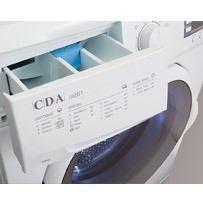Choosing the right temperature for your washing machine can significantly impact cleaning effectiveness, energy consumption, and the lifespan of your clothes. Modern detergents are often formulated to work efficiently at lower temperatures, benefiting both the environment and your wallet. However, understanding when to use different temperature settings is crucial. This guide provides a comprehensive overview of washing machine temperature settings and how to choose the best one for your laundry needs.
Understanding Washing Machine Temperature Settings
Different temperature settings cater to various fabric types and levels of soiling. Here’s a breakdown:
20°C (68°F)
Since 2013, washing machines have been required to have a 20°C cycle to promote energy conservation. This setting dramatically reduces energy consumption. It’s suitable for lightly soiled garments that need freshening up or delicate items like silk, boned dresses, and bras. Avoid overloading the machine at this temperature to prevent potential mold and grease buildup.
Pros:
- Energy saving and eco-friendly
- Reduced running costs
- Gentle on delicate fabrics
Cons:
- Increases risk of mold, grease, and odors
- Requires more frequent machine maintenance to prevent mold
30°C (86°F)
With the right detergent, a 30°C cycle can handle many everyday laundry needs. It’s a popular choice for saving energy while still achieving adequate cleaning. This temperature is ideal for wool, silk, heavily dyed fabrics, and items prone to shrinking. It also helps preserve vibrant colors.
Pros:
- Versatile temperature for many household loads
- Protects clothes from shrinking
Cons:
- Requires a quality detergent for optimal results
- Slightly higher running costs than 20°C
40°C (104°F)
This is a commonly used temperature setting for washing a wide range of clothing items. It’s effective for cotton, acrylics, acetate, and blended fabrics like wool mixes and polyester blends. While 30°C is gentler on delicate fabrics, 40°C is better suited for everyday clothing and more durable fabrics. Consumer testing boards often use this temperature to assess washing machine performance.
Pros:
- Popular setting for everyday clothing
- Effective for various fabric types
Cons:
- Not as gentle as 30°C for delicate fabrics
50°C (122°F)
This setting is designed to remove stains and dirt from blended or mixed material fabrics. It can also effectively clean cottons and linens. However, modern detergents often allow for washing these materials at 40°C with comparable results, making the lower temperature a more energy-efficient option.
Pros:
- Removes stains from blended or mixed fabrics
Cons:
- Often replaceable with a 40°C wash using modern detergents
60°C (140°F)
Washing at 60°C provides a noticeable improvement in cleaning results. It’s crucial to ensure that garments are suitable for this temperature before washing. This temperature is effective for killing bacteria and viruses and removing stains. It is highly recommended for washing towels and bedding. Using a quality detergent is essential to ensure effective bacteria removal.
Pros:
- Kills bacteria, viruses, and removes stains effectively
- Ideal for bedding and towels
Cons:
- Higher running costs
- Requires a good detergent to kill bacteria effectively
90°C (194°F)
This is the hottest setting and is not recommended for regular use. It is best reserved for brightening whites, removing stubborn stains on cotton or linen, sanitizing heavily soiled items, or performing a maintenance wash on your machine. Always check clothing labels to ensure they can withstand high temperatures, as hot water can cause shrinking and color fading.
Pros:
- Removes stubborn stains and brightens whites
- Suitable for routine machine maintenance
Cons:
- Can shrink and damage clothes
- Can fade colorful fabrics
- Requires careful attention to clothing labels
Temperature Considerations for Different Fabrics and Situations
Choosing the right temperature also depends on the type of fabric and the level of soiling.
Cold Water (20°C – 30°C)
Washing in cold water saves energy and reduces electricity costs. You can save an average of 57% on your washing machine running costs when washing at 30°C. Cold washes are ideal for:
- Dark or bright colors that may run
- Preventing clothes from shrinking
- Shirts, light summer clothing, t-shirts, sportswear, jeans, and heavily patterned colored clothes
Note that you may need to use more detergent and pre-soak heavily soiled items when washing in cold water.
Warm Water (40°C and above)
Generally, 40°C and above can be considered a warm wash. Most clothing can be washed at these temperatures with minimal shrinking. Warm water washes are ideal for:
- Towels, underwear, and bed linen
- Durable everyday fabrics like wool
- White clothing that needs brightening
Be cautious with heavily colored clothing, as warm water can still cause colors to fade or bleed.
Hot Water (60°C – 90°C)
Hot water is best for heavily soiled items, such as:
- Towels, bed sheets, and baby nappies
- Clothes with fat-based stains like oil or butter
- Heavily soiled white clothing (check the label first)
Hot water washes require more energy and a longer cycle time.
 Washing Machine Temperature Guide
Washing Machine Temperature Guide
What Temperature Kills Bacteria in a Washing Machine?
The NHS recommends washing household linen, towels, and underwear at 60°C to prevent the spread of germs. While higher temperatures can kill germs, 60°C is generally adequate. Using a good detergent is crucial for killing bacteria effectively at any temperature.
Choosing the Right Temperature for Specific Items
- White Clothes: Heavily soiled whites like towels and bedding should be washed in warm or hot temperatures. Delicate fabrics like lingerie are better washed in lower temperatures.
- Colored Clothes: A cold wash is best for colored clothes to prevent bleeding and fading. Use temperatures between 20°C and 30°C.
Conclusion: Maximizing Washing Machine Efficiency
Understanding the different temperature settings on your washing machine is essential for achieving optimal cleaning results, conserving energy, and prolonging the life of your clothes. By following this guide, you can make informed decisions about which temperature to use for different fabric types and levels of soiling, ensuring that your laundry is clean, fresh, and well-cared for. Remember to always check the care labels on your clothing for specific recommendations.